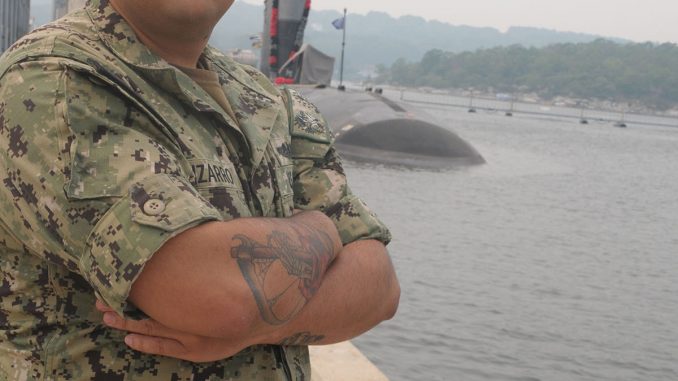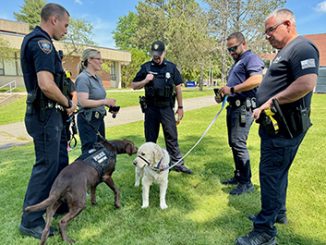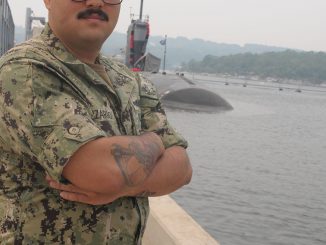
Haverhill native continues a 123-year tradition of service under the sea
By Ensign Rebecca Ives, Navy Office of Community Outreach
GROTON, Conn. – Submariners make up only 10 percent of the U.S. Navy’s personnel, but they play a critical role in carrying out one of the Defense Department’s most important missions: strategic deterrence. Petty Officer 2nd Class Xzayvier Pizarro, a native of Haverhill, Massachusetts, is one of the sailors continuing a 123-year tradition of service under the sea to help ensure Americans’ safety.
Pizarro joined the Navy three years ago and today serves as a logistics specialist aboard USS Indiana.
“I joined the Navy for a better life,” said Pizarro. “I also joined to see the world and what else is out there.”
Pizarro attended Haverhill High School and graduated in 2020.
Skills and values similar to those found in Haverhill are important to succeed in the military.
“I learned in Haverhill to seek out opportunities and not take anything for granted,” said Pizarro. “The Navy has given me so many opportunities and I never want to take any of them for granted.”
These lessons have helped Pizarro while serving in the Navy.
Known as America’s “Apex Predators!,” the Navy’s submarine force operates a large fleet of technically-advanced vessels. These submarines are capable of conducting rapid defensive and offensive operations around the world, in furtherance of U.S. national security.
There are three basic types of submarines: fast-attack submarines (SSN), ballistic-missile submarines (SSBN) and guided-missile submarines (SSGN).
Fast-attack submarines are designed to hunt down and destroy enemy submarines and surface ships; strike targets ashore with cruise missiles; carry and deliver Navy SEALs; conduct intelligence, surveillance, and reconnaissance missions; and engage in mine warfare. The Virginia-class SSN is the most advanced submarine in the world today. It combines stealth and payload capability to meet Combatant Commanders’ demands in this era of strategic competition.
The Navy’s ballistic-missile submarines, often referred to as “boomers,” serve as a strategic deterrent by providing an undetectable platform for submarine-launched ballistic missiles. SSBNs are designed specifically for stealth, extended patrols and the precise delivery of missiles. The Columbia-class SSBN will be the largest, most capable and most advanced submarine produced by the U.S. – replacing the current Ohio-class ballistic-missile submarines to ensure continuous sea-based strategic deterrence into the 2080s.
Guided-missile submarines provide the Navy with unprecedented strike and special operation mission capabilities from a stealthy, clandestine platform. Each SSGN is capable of carrying 154 Tomahawk cruise missiles, plus a complement of heavyweight torpedoes to be fired through four torpedo tubes.
“Our mission remains timeless – to provide our fellow citizens with nothing less than the very best Navy: fully combat ready at all times, focused on warfighting excellence, and committed to superior leadership at every single level,” said Adm. Mike Gilday, Chief of Naval Operations. “This is our calling. And I cannot imagine a calling more worthy.”
Strategic deterrence is the nation’s ultimate insurance program, according to Navy officials. As a member of the submarine force, Pizarro is part of a rich history of the U.S. Navy’s most versatile weapons platform, capable of taking the fight to the enemy in defense of America and its allies.
“This world is mostly water and the Navy covers a lot in terms of protecting our country,” said Pizarro. “Whether it’s surface fleet or submarines, we are a constant presence to defend the U.S. against adversaries.”
As Pizarro and other sailors continue to train and perform missions, they take pride in serving their country in the United States Navy.
“Serving in the Navy is a sense of pride,” said Pizarro. “I was the first in my family to ever graduate high school. I had a single mother who raised three boys. She taught me there is so much more of the world to see. By being in the Navy, I’m showing my two younger siblings there is more out there.”
Pizarro is grateful to others for helping make a Navy career possible.
“I am grateful for my mother because she is one of my biggest supporters,” added Pizarro. “She kept pushing me to try even when others didn’t believe in me.”




Be the first to comment